and historical purposes, all rights reserved.
This page is copyright© by
This page may not be sold or distributed without
the expressed permission of the producer
I have no connection with any camera company.
The next page contains information on this camera.
If the image below looks like your camera,
click below to see the PDF manual.
This camera manual library is for reference
and historical purposes, all rights reserved.
This page is copyright© by
![]() - NJ.
- NJ.
This page may not be sold or distributed without
the expressed permission of the producer
I have no connection with any camera company.
On-line camera manual library - M. Butkus, Librarian
If you find this manual useful,
how about a donation of $3 to:
M.
Butkus, 29 Lake Ave.,
High Bridge, NJ 08829-1701
and send your e-mail address
so I can thank you.
Most other places would charge
you $7.50 for a electronic copy
or $18.00 for a hard to read Xerox copy.
Click here for main Camera Manual site
<<<
IF YOU WOULD LIKE THIS OR ANY PDF FILE
PRINTED, BOUND AND MAILED TO YOU,
SEE THIS OUTSIDE COMPANY'S OFFER
>>>
RIGHT CLICK ON MANUAL BELOW,
CHOOSE "SAVE TARGET AS"
SAVE TO FOLDER OF YOUR CHOICE
Problems
opening PDF files or printing problems
- click here
CLICK HERE TO CONTINUE TO
Agfa Recorder I - II PDF MANUAL
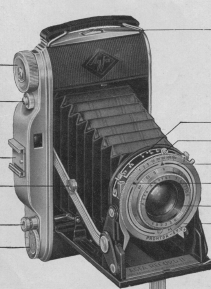
Translated via Google after OCR. This was very difficult and the translation is not perfect.
The Agfa Record I and
ll models are hardly different from one another in as it relates to their
exterior. As for the material they are
absolutely equal. Their narrow objectives are
perfectly corrected anastigmats which are also very suitable for
Agfacolor photography.
The Agfa Record ll is
equipped with an Agfa Apotar lens or the Agfa Solinor enclosed housing
objective and Prontor S, SV or Synchro-Compur shutters. In these models
has a blocking device against double exposure.
 |
1. Film advance button 2. Close button 3. Slide for accessories 4. articulated scissors (to open and close the device) 5. Trigger button and splitter-signal of blockage of the film (Record ll) 6. Depth of field ring 7. Camera back lock 8. Diaphragm scale 9. Shutter cocking lever 10. Exposure time registration mark 11. Distance setting marker 12. Ring or focus of distances 13. Exposure time ring 14. Support for wide shots 15. Support for overhead shots |
 |
To open the
camera back: Push the lock under the belt in the direction of the arrow. Open the back of the device. To load the 6x9 B2 (120) film camera Never change the device in direct sunlight, but only in dim daylight. Tilt the spool holder and pull out the tab of guide. The empty spool should be in its housing next to the belt. When you press the close button (number 2, page 2) the lens holder slides forward and engages bootie. It is appropriate, for this maneuver, to incline the back slightly forward. it is sometimes necessary, e.g. when the appliance has been at rest, to help a little with the hand this setting until the fastening clicks. The advantage of the Agfa Record I is that scissor device resides in its setting in the blink of an eye. The careful construction of the scissors ensures a particularly robust stability of the lens holder. |
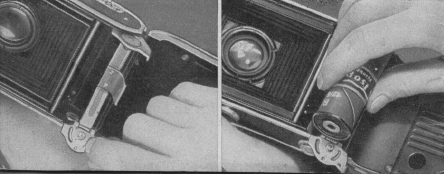
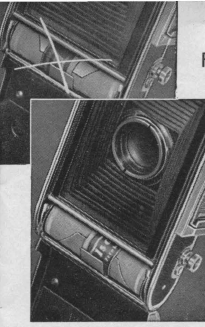 |
Not correct Insert the reel of film in such a way that the pointed end of the protective paper is directed towards the empty spool. Open the sticky tape and remove it carefully, pull the protective paper and slip the tip of it the longest slot of the empty spool. |
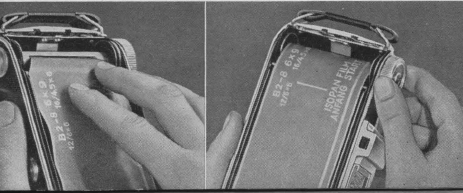 |
Turn film drive bolt to tighten the paper; adjust the paper, pushing it properly, so that the tape rolls up quite exactly - that is to say without letting in light - between the two edges of the empty spool. |
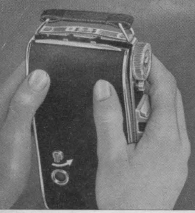 |
Press hard, two hands the back of the device until we hear the closing click. |
|
Viewfinder. Closer to the eye the optical viewfinder in such a way that the field of its anterior lens is visible up to the corners. Way to hold the camera for the pictures in length... Find a position quite stable. Hold the device right: don't tilt it in any direction. Press down on the release button of the box, regularly and without haste, with the index finger of the right hand. |
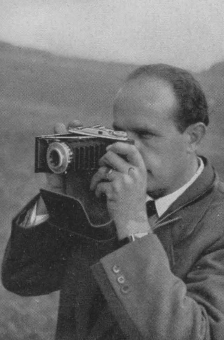 |
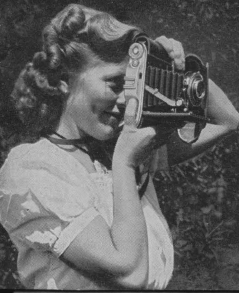 |
. . and
for height images Operate by weighing gently with the thumb of the lower right, on the trigger button. Do not weigh in spurts, to avoid pictures <aspen>. Always press the trigger all the way! |
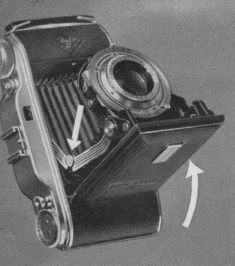 |
Method
of closing the device: Weigh with two fingers from top to bottom on lens holder scissors; pressure on the closed button of the device and you should hear the click of closing. Attention! Set the distance to infinity and remove the yellow screen and the flexible trigger. Before closing the appliance, re-enter the small support (14 page 2) fixed on the flap, if it has been used. |
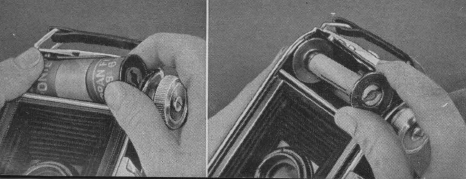 |
| To
unload the camera: After the last (8th) shooting, continue to turn the button film drive until the end of the protective paper from the reel passes in front of the window. Open the back of the device. Exit completely the training button. Carefully pull out the full spool - the paper should not unroll - fold the end of the popier, glue it and wrap the film in such a way that it is protected against the light. Place the empty spool in the housing next to the belt, the end to the axis split rotates on the side of the drive button. |
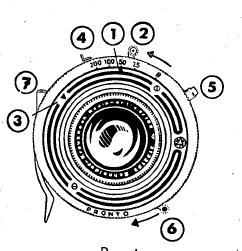 |
SHUTTERS Agfa Record I with shutter Pronto or Vario |
| Pronto Speed: B, 25, 50, 100, 200 Distances (meters): 1 - 1.2 - 1.5 - 1.7 - 2 - 2.5 - 3 - 4 - 6 - 10 - oo Diaphragm: 4.5 5.6 (6.3) 8 11 16 22 |
Vario Speed: B, 25, 50, 200 Distances (meters): 1 - 1.2 - 1.5 - 1.7 - 2 - 2.5 - 3 - 4 - 6 - 10 - oo Diaphragm: 4.5 5.6 (6.3) 8 11 16 22 |
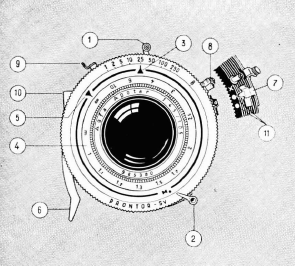 |
Agfa Recorder II with Prontor S - Prontor SV Synchronisio integro Speed: B, 1, 2, 5, 10, 25, 50, 100, 250 |
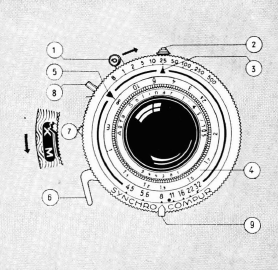 |
Agfa Recorder II with Synchro-Compur Synchronisio integro Speed: B,1, 2, 5, 10, 25, 50, 100, 250, 500 Distances (meters): 1 - 1.2 - 1.5 - 1.7 - 2 - 2.5 - 3 - 4 - 6 - 10 - oo |
1. Shutter cocking
lever: Cock the shutter, before each shot, up to the stop (also for “B”).
2. Self-timer lever (and synchronization for
Prontor SV), unusable in position B and I/500 - delay about 7 seconds.
Continuation of
manipulations:
1. Arm the shutter.
2. Arm the retarder; for the Compur, after pushing button 2 arms lever 1 again.
3.
Trigger.
3.
Exposure time setting mark - turn the outer knurled ring; the mark
indicates the chosen time.
4. Front lens frame.
5. Distance adjustment mark: Turn the desired
distance.
6.
Shutter release lever.
7. Lever controlling X or M synchronization
(for Prontor SV and Synchro-Compur only).
8. Flash socket; diameter 3mm.
9. Scale and aperture adjustment lever.
10. Socket for flexible trigger.
11. Reference points for X or M
synchronization (Prontor SV).
For indications 2, 7 and 11, see
the following pages.
FLASHING TECHNIQUE WITH AGFA CAMERAS -
(these are
flash bulbs, no electronic)
The
different flash lamps obtained on the market are distinguished: by the
lighting time, by their intensity of light and by the time
which flows between the contact and the
ignition of the lamp.
Integrally synchronized shutters are adapted
to these different properties.
With fixed focus synchronization (Shutter and
Vario, Pronto and Prontor S)
the lighting of the lamp takes place at the
moment of maximum opening of the sectors of the shutter.
But its use is restricted to low speeds, e.g.
ex.1/25 sec. This is called X synchronization use, in addition to this
synchronization X, the synchronization M.
Unlike synchronization X, which is fixed, we
can, by the synchronization M, delay the opening of the shutter by a few
thousandths of a second and thus use the flash technique with
the highest speeds.
Table 1: gives all the
necessary information regarding the position of the synchro lever for X
and M synchronization with or without use of the self-timer.
For shots without flash the position of the
synchro lever is indifferent - except for one exception - if you want to
use the self-timer with the Prontor SV shutter, you must ensure that the
synchro lever 7 is in the red X position, otherwise the movement for
delay does not work.
For flash photography, the exposure time must
be chosen according to the
distance from subject and type of flashlamp
used. Refer to the instructions for use which
found with the flashlight.
Table 2: gives all the
necessary indications for the adjustment of the lever and speed, for X
and M synchronization, depending on the types of lamps most
currents.
| Lever positions for flash shots In any case, the cable plug must be connected at flash socket 8 | ||
| Shutter | X Sync | M Sync |
| Vario | No switching leverage |
Not possible |
| Pronto without and with time delay | Automatic ignition of the flash | Not possible |
| Pronto S without and with time delay | Cable connection - see above | Not possible |
| Prontor SV with self timer | Synchro lever 7 on Red X | Synchro 7 lever on yellow dot tip. Arm at end of stroke delay lever 2 |
| Prontor SV without delay | Synchro lever 7 on red X. Arm at end of stroke delay lever 2 | With synchronization delay M not possible |
| Synchro-Compur without delay | Synchro Lever 7 of X | Synchro lever 7 on M X |
| Synchro-Compur with delay | Synchro lever 7 on X, push back button 2 and continue cocking | With synchronization delay M not possible |
| See shutter illustrations - pages 11-13 | ||
These are flash bulb settings.
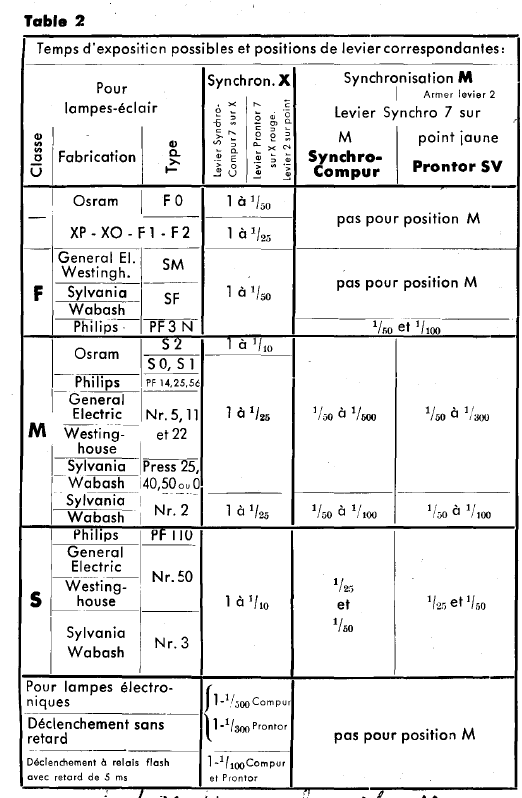
Depth of field without any
calculation
The depth
of field is the extent in depth of the zone of perfect sharpness of the
image since
in
front to the bottom of the motif to be photographed.
In front of the point on which the distance is
set, the zone of sharpness is less deep than behind this point.
When focusing on a
near object, the area of sharpness is less than when focusing
takes place at a point located at a greater
distance.
 Large diaphragm p. ex. 4.5 = |
High light intensity, bright but low depth of field. |
 Small diaphragm, e.g. ex. 16 = |
Low light intensity but great depth of field. |
By choosing small apertures (higher
numbers), you obtain a greater depth of field (see the table on page
19).
The
simplest way is to stick to two-point rule focusing. For snapshots this
is almost always enough.
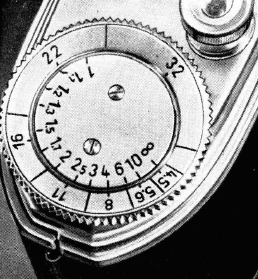 |
The depth of field ring fixed on the upper plate of the camera constitutes a very useful supplementary working aid. If, by turning the outer ring, we place p. ex. the diaphragm 8 on the number 4 (meters) of the inner disc, the field limiting the zone of the diaphragm 8 shows us the limits of the depth of sharpness from the most advanced point to the most backward point, that is to say approximately from 3 to 6 m. |
| Setting of the diaphragm | Setting distance | Depth of field. sharpness between distances |
| Red point between 8 and 11 |
3m. (proximity) 10m. (distant) missed in red |
2.5m.-5m.
and 5 m.- 00 Areas that will be out of focus. |
What is viewfinder parallax?
| Don't be put
off by this complicated word - the thing is very simple. The axes of the lens and the optical viewfinder are not at the same height. But they are already set so that, in most views, the viewfinder image coincides with the lens image. For images taken up close, if you want the edges of the image to correspond exactly to the sight, you have to hold account for a slight offset known as parallax of the viewfinder. |
 |
| In close-up
shots (at less than 2m.) we see the upper part of the image a little less than in the viewfinder. |
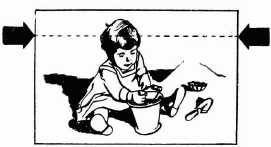 |
Depth of field in meters.
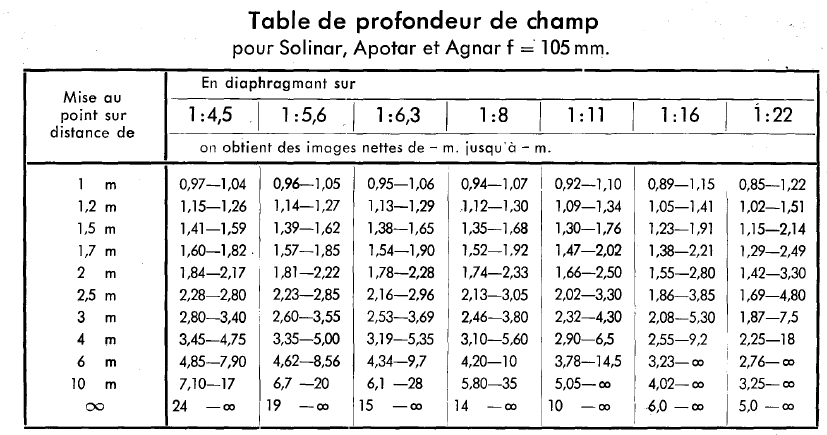
The numbers in this depth-of-field table are calculated to meet the highest demands of negative sharpness. We can therefore also count on a very satisfactory sharpness even in an area substantially exceeding the frame indicated in the table above.
| Film17 / 18 DIN - ASA Exposure index 40 | ||||
| Time of exposure: from 3h. after sunrise 1 until 3 hr. before sunset | ||||
| Pattern | Season | sunny - cloudy - dark | Exposure time in seconds | When using the medium yellow Agfa filter, open the diaphragm one stop more (near lower figure), i.e.: double the exposure time |
| Bright subjects, snow, beach, etc. | Summer | 16 - 11 - 8 | 1/100 | |
| Winter | 11 - 8 - 5.6 | 1/50 | ||
| Children, outdoor groups, landscapes, etc | Summer | 8 - 5.6 4.5 | 1/50 | |
| Winter | 5.6 - 4.5 - none | 1/25 to 1/10 | ||
| In a bright room, near the window | Summer | 5.6 - 4.5 - none | 1/10 - 1/5 - 1/2 | |
| Winter | none - none - 4.5 | 1/2 - 1 sec. to 2 sec. | ||
| When in doubt, it is better
to expose too long than too little! Exposures longer than 1/2S sec. are likely to be shaken. “B” poses should be done using a tripod. The cable release can be screwed into the thread of the release button. |
||||
Comparative table of film speed
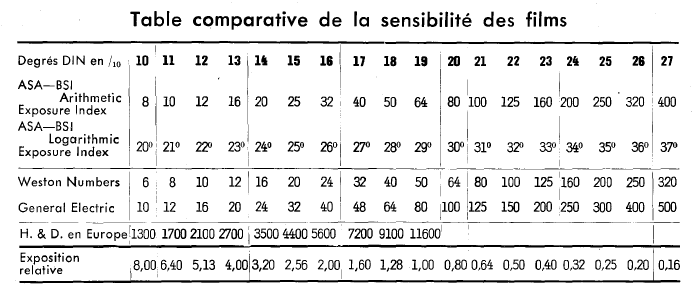
In the table, the films of equivalent
sensitivity are placed one under the other.
Figures in the "Relative Exposure" heading are
comparative figures indicating the proportional value light required for
films of different speeds. For example, a 16/10 DIN film requires twice
as much light as a 19/10 DIN film (difference 3/ 10° DIN). Practically
it means that it is necessary to use a larger diaphragm opening or to
double the exposure time.
With the Agfa device -
Agfa filters and lens hoods
Agfa
filters are used to render the various colors by the exact values
corresponding in the range from black to white.
We provide quality
filters, uniformly colored in the mass, rigorously plan parallel and of
nature, has to satisfy the greatest requirements.
Densities: light
yellow, medium yellow, yellow green and red-orange.
The use of
filters naturally requires a longer exposure. We use at this effect the
pose extension factors which depend mainly on the
movie awareness.
Film manufacturers indicate on the packaging which are the extension
factors to be taken into account for the highest filter densities
currents. When these indications are lacking, the following data will
serve as a standard for the panchromatic films:
| Filter light yellow No.1 |
Exposure factor filter 1.5 - 2 |
| medium yellow No.2 | 1.8 - 2.3 |
| yellow-green No. 7 | 1.2 - 2.5 |
| red-orange No.7 | 4 |
.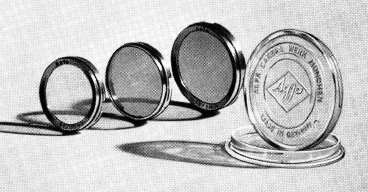
In addition we provide an Agfa lens hood in
plastic material, in its frame metal, for the diameters mentioned above.
Screens and lens hood in protective transparent case.
The lens hood provides
effective protection against direct frontal or lateral incidence of
light rays. This is why it lends itself especially to taking backlit
shots or reading shots artificial light or lightning where the light
source is closer to the object than the device photographic.